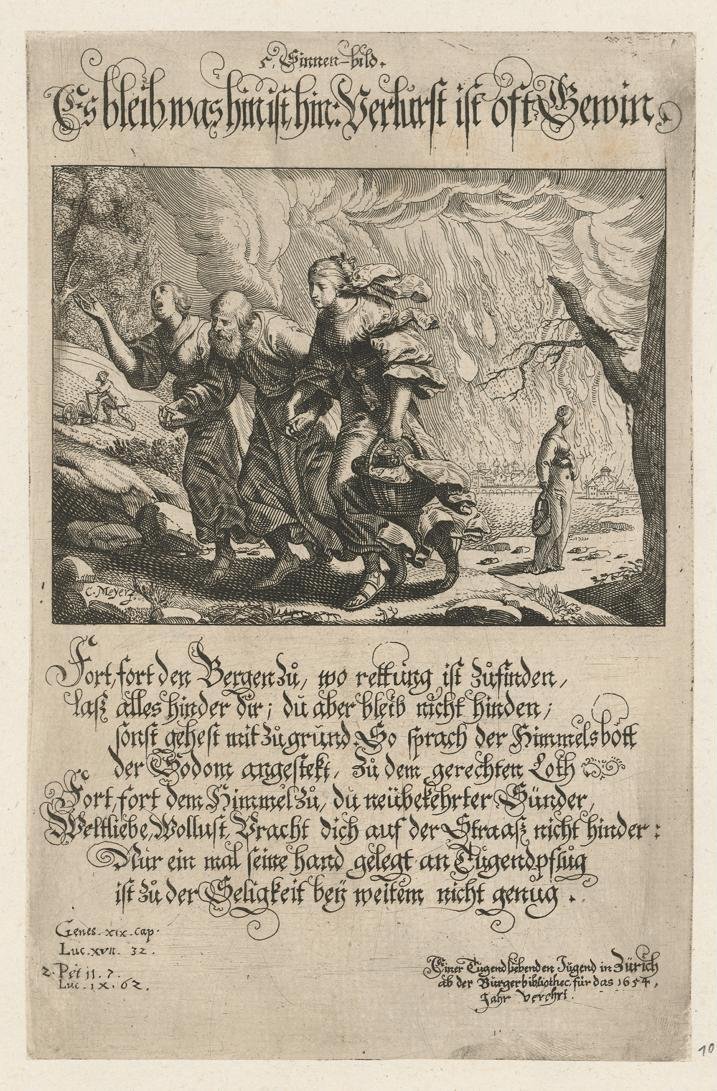New Year's leaflet 1654

Conrad Meyer
Es bleib, was hin ist, hin; Verlurst [sic] ist oft Gewin
Neujahrsblatt auf das Jahr 1654
Radierung, 10 x 13,6 cm, Zentralbibliothek Zürich, Graphische Sammlung
For over 300 years, the Zentralbibliothek Zürich, once founded as a citizens' library, has been publishing so-called New Year's Leaflets at the turn of the year. This tradition goes back to Conrad Meyer. Together with the poet and theologian Johann Wilhelm Simler, he published the first New Year's leaflet in 1645. Meyer designed the illustrations and Simler wrote the accompanying verses. The mostly instructive and moral sheets were aimed at the youth of Zurich.
Meyer chose a narrative scene for the 1654 New Year's leaflet, dedicated to "A virtue-loving youth in Zurich": the biblical story of the flight from Sodom – a city symbolic of moral decay and sinfulness.
Meyer's composition focuses on Lot's dramatic escape: supported by his two daughters, Lot, bent over with age, saves himself from the sinking city. His wife, facing the burning Sodom, is already frozen to a pillar of salt. A gloomy sky, filled with smoke and flames, lies above the scene. The landscape is familiar, bringing the biblical events into Meyer's time. On the left-hand edge of the picture, a farmer interrupts his work in the fields and gazes in amazement at what is happening – a doubling of looking back and a contrast between everyday life and divine punishment. It refers to the Gospel of Luke, where Jesus says: "No one who has put his hand to the plow and looks back again is fit for the kingdom of God." (Luke 9, 26) And later, when talking about the Last Day, it says: "He who is on the housetop on that day and has his household goods in the house, let him not go down to get them. And likewise, he who is in the field, let him not turn back to what is behind him. Remember Lot's wife!" (Luke 17, 31)
Meyer's New Year's leaflet serves as a warning against the consequences of moral decay and calls for the preservation of social order and civic virtues – following the example of Lot.
Until Simler's death in 1672, the two published the New Year's leaflets almost without interruption; Meyer continued this work until 1684. Between 1668 and 1673, Meyer also created illustrations for the New Year's pages of the Winterthur Citizens' Library, which was founded in 1660.
For those who are not familiar with the bible: The story of Sodom and Gomorrah
The cities of Sodom and Gomorrah were notorious for the sinful behavior of their inhabitants, so God decided to punish them. But he wanted to give them one last chance: If at least ten decent people were found, he would spare the cities.
God then sends two angels to the presumed den of iniquity, where they meet Lot, a pious nephew of Abraham. However, the other inhabitants of Sodom confirm the worst fears, and as punishment it is to rain fire and brimstone on the city.
Only the godly Lot and his family are warned and can flee the doomed city on one condition: they must not stop and look back. While Lot and his daughters follow this instruction, his wife cannot resist the temptation. She takes one last look at the city – and is instantly turned into a pillar of salt.


